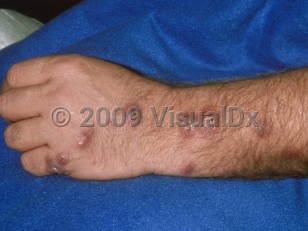The lesions of sporotrichosis may present in 3 different patterns.
- Lymphocutaneous or sporotrichoid pattern – 75% of cases
- Fixed cutaneous – no lymphatic dissemination; may be more likely to develop in patients previously sensitized to S schenckii
- Disseminated cutaneous – occurs with systemic involvement; rare and usually in the context of immunosuppression such as oral prednisone therapy, other immunosuppressive medications, alcohol use disorder, diabetes mellitus, hematologic malignancies, and AIDS
Thorny plants, such as barberry and rose bushes, are the most common source of cutaneous inoculation of sporotrichosis. Other plant exposures include sphagnum moss, straw, hay, soil, and mine timbers. Occupational exposures include farmers, florists, gardeners, and forestry workers. Zoonotic transmission from scratch injury or bites of infected cats, rodents, or armadillos has been reported but is a less common mode of transmission.
Untreated cutaneous sporotrichosis usually waxes and wanes over months to years without systemic manifestations.



